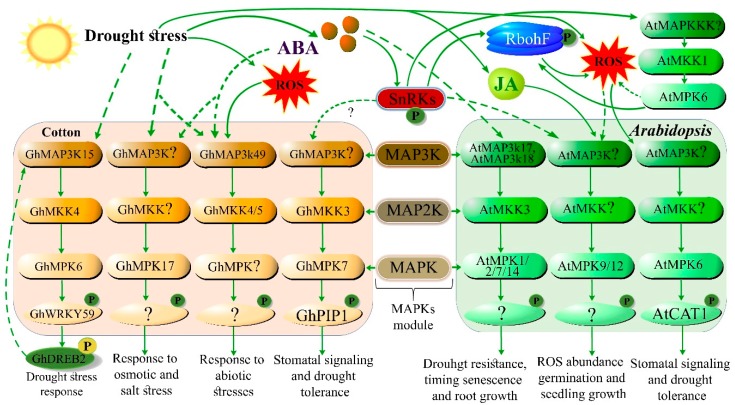Figure 2.
Drought-induced, ABA-dependent, ABA-independent MAPK signaling, and interaction between ABA, ROS, and MAPK signaling under drought stress in plants. ABA-regulates various MAPKs in cotton and Arabidopsis. ABA promotes drought sensing and signaling in plants. The different cascades are represented by different color schemes in the figure. Solid arrow lines denote established signaling mechanisms, while dashed arrow lines denote unestablished signaling pathways. ABA-activated SnRK2s (See Figure 1 for SnRK2 activation) trigger and phosphorylate downstream targets, such as respiratory burst oxidase homolog (RBOH) and various MAPKs. Activation of RBOH induces ROS production. ROS signaling and ABA signaling may overlap with MAPK factors, to interact and regulate drought tolerance. MAP3K17/18-MKK3-MPK1/2/7/14 is an ABA-induced complete MAPK cascade involved in stomatal signaling, senescence, and drought tolerance mechanisms in Arabidopsis. In addition, MKK1 activates MPK6 to positively regulate CATALASE1 (CAT1) for ROS abundance. In cotton, the drought- and ABA-induced MAPK cascade MKK3-MPK7-PIP1 is associated with stomatal signaling and drought tolerance. Another ABA-mediated MAPK module, MAPKKK49-MKK4/MKK5, is associated with abiotic stress responses. GhMPK17 gene is a novel, well-characterized MAPK, which is associated with responses to osmotic and salt stresses in cotton. An ABA-independent and drought-mediated MAPK module (MAP3K15-MKK4-MPK6-WRKY59) regulates drought tolerance in cotton. Drought stress triggers the MAPKKK15 cascade, which phosphorylates the WRKY59 transcriptional factor. Interestingly, WRKY59 binds to the promoter of DREB2 and regulates the expression of drought-sensitive genes. Meanwhile, it positively regulates the expression of MAP3K15 by establishing a feedback loop, which regulates drought tolerance in cotton.

